Eating our way across Quebec : Plessisville to Victoriaville
We trekked along through the beautiful morning, relatively carefree and enjoying the peaceful, pastoral, countryside. For a small stretch we noticed multicolored scarves tied to trees and fence posts along the trail, but we weren't sure what their meaning was - perhaps a reminder of the missing or murdered Indigenous women and girls?
Today began in the very best way possible - with a delicious breakfast of strong, hot coffee and warm crepes filled with fresh bananas, strawberries, and Nutella at L'Ouefrier. I apologize for the lack of a photo, but after spending several hours this morning writing and catching up on other work, the phone's battery needed time to recharge while we went for breakfast. I leave you to imagine the warm, buttery, delicious French feast of perfection for your yourself.
Thus fortified, we set out into a gorgeous sunny morning, heading back through town to the trail. We picked it up again at the beautifully landscaped Halte Sommerset (named after the town's original moniker) which had benches, a metal sculpture of a cyclist in action, and a restored CN railway carriage.
As we followed the paved pathway through the tiny linear park we stopped to read one of the interpretive signs, which provided a history of Forano, or the 'Plessisville Foundry.' It was incorporated in 1882, and gradually expanded its operations throughout Quebec, British Columbia, and the State of Georgia, becoming well known around the world for its expertise in manufacturing forestry equipment, agricultural machinery, and mining machinery.
At the edge of town the pavement gave way to a crushed stone dust pathway once again, and we were surrounded by a corridor of yellow, orange, and red sugar maples that were set ablaze in the strong, warm, sunshine. Although it feels like we are walking only a few steps ahead of the maintenance crews who are closing the trail for the season, there were a lot of people out enjoying the gorgeous fall weather. We exchanged friendly smiles with people of all ages, including young mothers pushing baby carriages, people out jogging, and a retired gentleman in an electric scooter. We've noticed a lot of older folks out riding electric scooters on the trails in Quebec, which is a really encouraging sign that they are truly accessible.
Other small things along the trail also caught our eye, like the fuzzy black and brown woolly-bear caterpillars hurrying across the trail bed, and the clumps of juicy, ripe, red berries hanging from the bushes. At one point we spotted what we thought were a few Common Grackles talking quietly to each other in the bushes, but when we approached a whole flock of them took to the air in a great unexpected 'whoosh!' A short distance later two Ruffed Grouse erupted out of the shrubs in another great kerfuffle.
When we approached the edge of Princeville we spotted two beautifully carved wooden benches that looked like church pews or old railway station benches sitting out in the open under a colourful maple tree. A sign in front of the rating spot said it was the site of a future community garden.
A few steps farther along we came to a first on this rail trail - a tunnel! The square concrete sides were covered in colourful and thought provoking street art, which prompted a discussion on how street art reflects the region it is in, and how it seems to have changed as we cross the country. As we passed underneath the busy road, we were grateful to have our own pathway.
We followed the trail past rows of homes, and into the centre of town, where we
found a beautiful rest spot in a large urban park. It was adjacent to a
charming looking downtown, and just down the street from the Presbyter
Princeville, which was a large grey stone church with twin steeples and several
elaborate rose windows.
We stopped for a break in a gazebo in the park, and paused to read a few of the interpretive signs in the well-landscaped green-space. While historical plaques and interpretive signs in the rest of Canada are almost always presented in at least two languages (English and French), and frequently in three (the language of the Indigenous Peoples in the area), the signs in Quebec are often only written in French. This makes me regret my very limited French language skills, because I feel like a lot of the local history, which I really enjoy learning as we hike across the country, is lost to me.
From what I understood from one of the interpretive signs in the central park, Princeville, which was originally named Stanfold, was founded in 1807 by Édouard Leclerc. In 1969 the town was renamed after Pierre Prince (1797-1863), who was a generous, wealthy, and very well respected and loved businessman who made a fortune in the town. When his only son Pétrus took over the family business, Pétrus caused it to go bankrupt, and soon afterwards moved away and disappeared with his family and eight children. Pierre Prince moved to Notre-Dame de Ham, where he still owned a house, a mill, and a post office. Upon is death the citizens of Princeville were invited to mourn for a period of two weeks be absent he was still a much loved figure in the town.
As we made our way under the arbours across the trail in the park, and headed towards the edge of town we spotted a set of wooden stairs leading up a grassy embankment with a large sign for the Boulangerie Lemieux. In my opinion, when you see a sign for a bakery right on the trail, you really don't have any choice but to go investigate. This bakery was opened in 1943 by Fernand Lemieux, and has been using the same recipes ever since.
When I entered the warm bakery, the delicious smell of baking bread enveloped me, and I was greeted with a huge selection of pastries, cookies, croissants, breads, quiches, and more. In the end I left with chocolate croissants, oatmeal cranberry and chocolate chip cookies, and delicious peanut butter and chocolate squares that were intended for outdoor adventure. As we enjoyed the croissants on a picnic table in the sunshine I realized it really has been a pleasure to eat my away along the Sentier Transcanadien in Quebec, even if I do come to resemble Winnie the Pooh by the time I reach Ottawa.
After leaving Princeville the trail hugged the highway. A row of young trees lined the pathway, creating a visual barrier between us and the fast paced traffic, but their leaves had fallen and the saplings were still young. Beside us the tall blond stalks of corn in an un-harvested field rattled as they swayed in the wind. Tall ornamental grasses along the trail also rustled in the wind, their soft tufty plumes shining in the sunshine. Leathery shrubs also grew along the pathway, their light green leaves interspersed with bright orange berries.
It felt a little bit more exposed in this section of trail, and the landscape seemed to bring back memories of the dry, tough, hardy vegetation in the prairies. Once again, we were incredibly grateful to have our own pathway instead of sharing the pavement with the traffic, and to be walking without dust clouds enveloping us.
As we walked today we saw a few more signs that closure of the trail for winter
is imminent, but the most firm indication was at the Pont de Billy bridge over
the Rivière Bulstrode. We paused to take a break at the Halte Velo by the
bridge, which had a covered picnic table. As we sat there we watched a
pair of cyclists dismount and push their bicycles under two chains that had
been stretched tightly across the bridge to prevent people crossing.
Shortly afterwards two pairs of retired folks on scooters came to the bridge,
found it closed, and then had to divert onto the shoulder of the very busy
highway. On the hot sunny afternoon this trail closure and chain
barricade seemed like an unnecessary measure that was creating an unsafe
situation. It also meant that in an undignified way I had to crawl on several occasions today. Unfortunately Sean could simply step over the chain which seems unjust to me.
As we approached Victoriaville the trail continued to closely parallel the highway, cutting through a beautiful pastoral landscape. Emerald green fields stretched out on both sides of us, broken by colourful red and white barns, tall grain silos, and small stands of trees still bright with fall colours. In the distance a range of rolling hills and mountains topped by wind turbines created a misty blue background.
Just before we reached Victoriaville, which was our endpoint for today, we walked through a small plantation of pines trees. A small Halte Velo was tucked into the trees, and it was occupied by another cyclist who looked like he was also on a long journey.
Victoriaville, which boasts the nickname 'Queen of the Bois-Francs Region,' is located on the Rivière Nicolet, and began developing in 1835. It was named Victoriaville in 1860 in honour of Queen Victoria, and today it is home to one of the last water mills that is still in operation. The Moulin La Pierre opened in 1945 and is a sawmill which also produces shingles and flour. Victoriaville is a major producer of numerous hardwood products, including furniture, caskets, and hockey sticks. The large town supports other industries as well, including a Lactantia dairy factory, two shopping malls, the Cegep de Victoriaville (post-secondary institute), and a small airport. The vibrant community also hosts several annual festivals, including the Week-end en Blues series of concerts, the Festival Internationalde Musique Actuelle de Victoriaville (FIMAV) in spring, and the Exposition Agricole in summer.
Victoriaville is also home to the Musée Laurier, which is a National Historic Site of Canada that commemorates the first French Canadian Prime Minister of Canada - Sir Henri Charles Wilfred Laurier (1841-1919). He was the 7th Prime Minister of Canada, serving from 1896 - 1911. Laurier had a summer home in Victoriaville, which is now used as the museum, and although we would have like to visit it, unfortunately it was 5 km off the trail (10km round trip), which was too far to add to an already long day, especially given the short hours of daylight we now have.
As we made our way through the town to a motel a man stopped his car and asked if we needed a lift somewhere, or if we needed a place to stay. We greatly appreciated his kindness, but already had a reservation at a local accommodation. As darkness fell and a very strong and cold wind began to blow, causing the temperature to plummet, we were once again grateful to be indoors. Overhead a huge and seemingly endless stream of Canada Geese are flying, reminding us of a piece of wisdom we heard in Saskatchewan - the weather will be fine until the geese leave, then you know winter is coming. The goose forecast is definitely predicting winter now. Hopefully it will grant us another 10 days grace to reach Montréal!
See you on the trail!
Remember to follow our entire adventure here : www.comewalkwithus.online









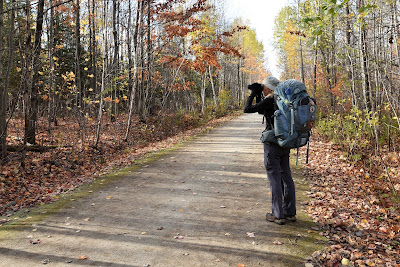
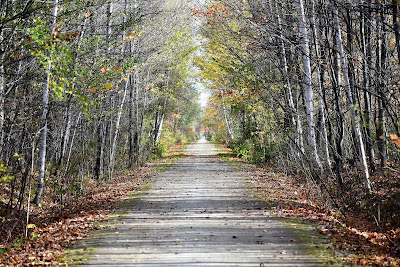




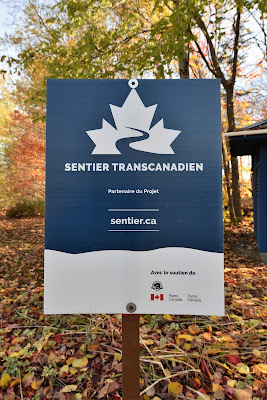









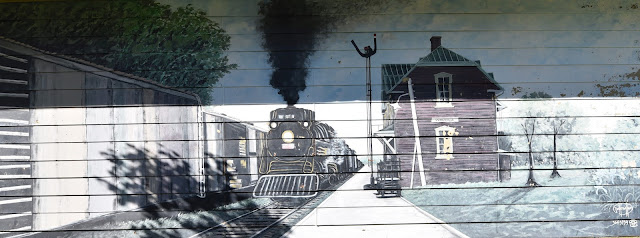
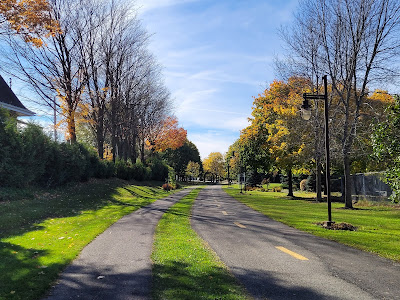


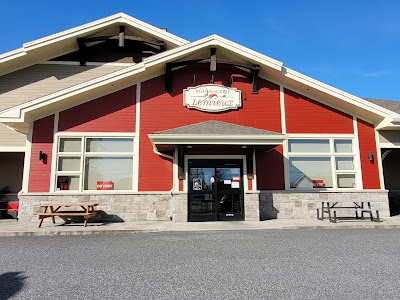












Beautiful photos. Thank you so much for sharing, and warm greetings from Montreal.
ReplyDelete